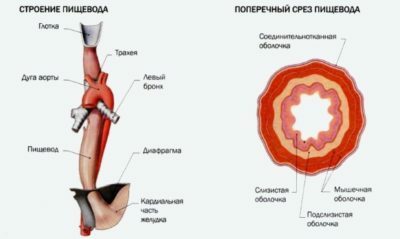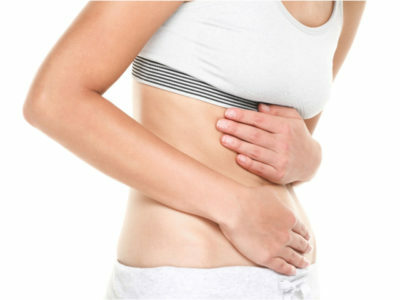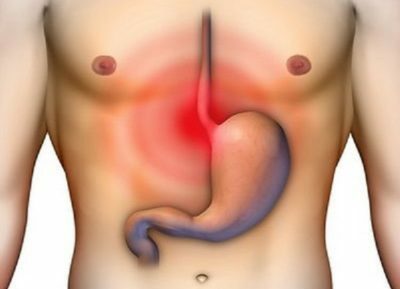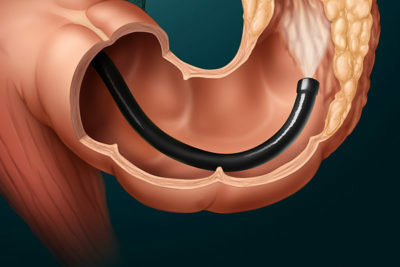1 Anatomical features of
In its structure, the esophagus resembles an elastic multilayer tube. Each section has a different diameter of the circle. In the inner part of the tube there are grooves and tubercles along which the liquid flows down into the stomach.

We recommend to read
- The causes of the appearance of fluid in the abdomen
- How the jaedings are treated
- What causes the pain in the esophagus
- Effective agent for gastritis and stomach ulcer
The layers of the esophagus:
- mucous layer;
- muscular layer;
- adventitious layer.
The main function of the esophagus is the unobstructed movement of food into the stomach. The esophagus is cyclically reduced, this is necessary in order for the food to move in the right direction. Everything happens naturally and does not cause discomfort. Being in a vertical position, the esophagus is adjacent to the aorta, diaphragm and nerve trunks. Two sphincters are located at the base and at the end of the esophagus. Their function is to skip the food first into the esophagus, and then into the gastric department.
During spasm of the esophagus there is a strong contraction of muscles, the lumen is partially or completely closed. Penetration into the stomach of food and even liquids becomes difficult or even impossible. At this time, the sick person is in great pain. To prevent this condition, it is necessary to know the causes of esophageal spasm.

2 Symptomatic of pathological condition
Esophageal spasm, common symptoms:
- In medicine, this condition is called esophagospasm. The very first and significant symptoms of this disease are chest pains and problems with swallowing. A person can not even swallow his own saliva.
- Stress can significantly exacerbate the situation. Pain radiates to various areas of the body, it can be scapula, lower jaw, shoulders. Especially acute pain manifests during exercise.

Usually the attack lasts for an hour, but in some cases this time is significantly increased. The doctor can pre-diagnose the disease precisely because of pain behind the sternum, as this is the main symptom of spasm of the esophagus.
-
 IMPORTANT TO KNOW! Gastritis? Ulcer? To have a stomach ulcer not turned into cancer, drink a glass. ..Read the article & gt; & gt;
IMPORTANT TO KNOW! Gastritis? Ulcer? To have a stomach ulcer not turned into cancer, drink a glass. ..Read the article & gt; & gt;
In the case of taking antispasmodics, pain can subside or disappear altogether. Esophagospasm develops both against the background of solid food intake, and when using soft food. In addition, a person first has heartburn. Many begin the process of regurgitation of food. This occurs against a background of acute spasms, and if a lot of food has accumulated in the esophagus.
As a rule, this condition develops mainly in people prone to hysteria, neuroses, neuropathic conditions and mood swings. The disease can develop rapidly or with a gradual increase, alternating with an improvement in the condition.
Spasms can be of a different nature of origin, which have symptoms peculiar to them:
- Diffuse spasm. During swallowing, there is an imbalance in muscle contraction. This state can manifest itself in different ways. Pain is most often felt in the area of the tube to the stomach. Discomfort can be felt in the neck, give into the shoulders. Most often, an attack occurs when the ability to swallow food is missing. Spasm lasts from several minutes to several hours. But the peculiarity of diffuse spasm is that hard food is swallowed more easily than liquid. This is an important symptom in the diagnosis. Such seizures can be repeated several times a month.
- Segmental spasm. Small areas of the esophageal tube contract. At the same time, each meal is accompanied by incredible pain, as food is difficult to eat. Many confuse such pain with the heart, but unlike cardiac spasms, the segmental spasms of the esophagus gradually build up and also gradually pass. If there is no timely treatment, the esophagus is gradually deformed. Sometimes surgical intervention may be required. It is worth noting that esophageal spasms can also be suffered by quite healthy people if they eat in a hurry and try to swallow large chunks of food.
- Nervous spasm. This is a convulsive contraction of the muscles, which develops involuntarily and unexpectedly. To cause such a state may be fright, stress or depression. In this case, spasm of the esophagus can develop even if the person has not yet sat down at the dinner table. The pain appears in the chest like a stenocardia. There are desires for vomiting. Food does not enter the stomach, but sticks in the esophageal tube. Need urgently calming drugs that are administered subcutaneously. Treatment is carried out by sedatives.
-
 Gastroenterologist. VAZHENOV: "I beg you, if you began to worry about abdominal pain, heartburn, nausea, do not do gas in any way. .."Read more & gt; & gt;
Gastroenterologist. VAZHENOV: "I beg you, if you began to worry about abdominal pain, heartburn, nausea, do not do gas in any way. .."Read more & gt; & gt;

3 Etiology of the phenomenon
The main reasons for the manifestation of spasm:
TIP FROM THE MAIN GASTROENTEROLOGIST
Korotov SV: "I can recommend only one remedy for the rapid treatment of Ulcer and Gastritis, which is now recommended by the Ministry of Health. .." Read testimonials & gt;& gt;
- Frequent intake of rough and hot food. If the food is unbalanced, then in the esophagus microcracks and micro-traumas are formed.
- Diseases of the dentition, for example, with improper installation of dentures.
- Prolonged intake of alcohol, against this background there is a permanent trauma to the esophagus, its burning with an alcohol-containing liquid.
- Infectious ailments, fungal, viral or bacterial diseases. For example, ARVI, influenza, scarlet fever, etc.
- Ulcer.
- Prolonged stressful situations, nervous overstrain.
- Ingestion of foreign objects into the esophagus.
- Meningococcal infection of the brain.
- Inflammations of various nature in the esophagus.

4 Emergency care for
If there is pain behind the sternum, the first thing to do is lie down and calm down. Wait 5 minutes if during this time the spasm of the esophagus has not passed, then the following actions are needed:
- If the pain occurred while eating, then calm down and drink a glass of water.
- Continue relaxation with respiratory gymnastics. Take a deep breath, hold for a few seconds and exhale slowly. Repeat this exercise up to 4-6 times.
- Drink a sedative. Especially if the attack has developed because of nervous overexertion. If there are no drugs at hand, prepare tea with mint or in extreme cases take a mint candy in your mouth.
- In case of ineffectiveness of these actions, an atropine prick is necessary.
WE RECOMMEND!
For prevention and treatment of Digestive Diseases our readers advise Monastic tea. This unique remedy consists of 9 medicinal herbs useful for digestion, which not only complement, but also enhance each other's actions. Monastic tea will not only eliminate all symptoms of the gastrointestinal tract and digestive system, but will also permanently eliminate the cause of its occurrence.
The opinion of doctors. .. "

Remember that at this moment there is nothing threatening a person's life. Therefore, first it is necessary to cope with the panic, since this is the first action to relieve the attack.
5 Diagnostic measures
As doctors say, 50% of recovery depends on timely and correct diagnosis. The basis of any diagnosis of the digestive tract is the analysis of stool and blood. In feces you can find spotting that indicates a helminth or other gastrointestinal disturbance.
If red blood cells are reduced in the blood, then this indicates anemia. With an increase in leukocytes, inflammatory processes are determined. Reproduction and colonoscopy are carried out. They determine the pathology of the rectum and large intestine.

6 Methods of therapy and prophylaxis
To be effective, it is necessary to make an accurate diagnosis. Especially in the case of spasm of the esophagus, since the attack often resembles the symptoms of angina pectoris.
Therefore, it is not superfluous to check the cardiogram of the heart rate. When the disease is determined, the treatment will appoint a doctor gastroenterologist. It provides for both medicamental and folk therapy. In addition, it is also necessary to maintain a stable state of the human nervous system.
The next step is a diet table and a sufficient amount of liquid. From the menu, cold and hot meals, spirits, products with coarse fiber, carbonated drinks are excluded.
It is worth while for a while to give up intensive sports, even bending forward and lifting weights is not recommended. Do not overeat at all. To prevent such a disease, you should monitor your diet, avoid stress, and treat infectious diseases in time. If there are already problems with the stomach, it is necessary to undergo an appropriate examination every year.
- 1 Anatomical features of
- 2 Symptoms of pathological condition
- 3 Etiology of the phenomenon
- 4 Emergency care
- 5 Diagnostic measures
- 6 Methods of therapy and prevention
When esophageal spasm occurs, symptoms and treatment are closely related. At the same time, a person experiences severe stress. Esophagus - this is a vital organ for a person, its functions are not replaced by any system of the body. And the treatment of the esophagus has its difficulties.
Spasm of the esophagus is a disease characterized by impaired motor ability of the smooth musculature of the esophagus. A person with difficulty swallows food, he has pain in the chest. According to statistics, this disease affects women aged 18 to 37 years. To develop the disease can be due to a variety of reasons, the main ones are infections, spicy food and the presence of stressful situations in life.
Do you have gastritis?
GALINA SAVINA: "How easy is it to cure gastritis at home for 1 month. A proven method - write down a recipe. ..!"Read more & gt; & gt;



